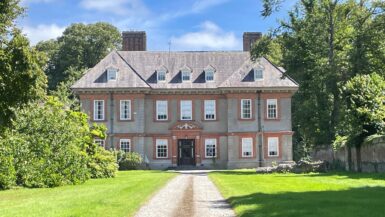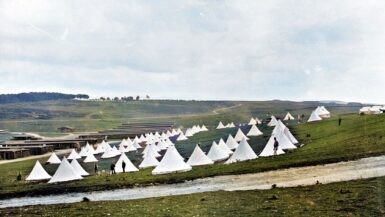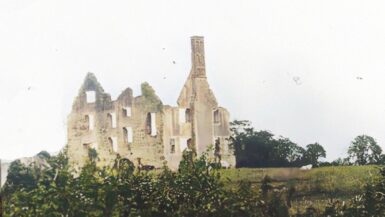The Origins of Clontarf Castle, Dublin, Ireland
In the heart of Dublin, Ireland, lies the majestic Clontarf Castle, a magnificent example of medieval architecture and a testament to Ireland’s rich history. For centuries, this iconic fortress has stood as a symbol of the nation’s rich past, surviving battles, destruction, and reconstruction. This comprehensive guide delves into the fascinating history of Clontarf Castle, providing an accessible and engaging look at one of Ireland’s most cherished landmarks.
The Earliest Days of Clontarf Castle
The story of Clontarf Castle, Dublin, Ireland, dates back to the 12th century when Hugh de Lacy, a powerful Anglo-Norman lord, established the fortress in 1172. Situated in the picturesque coastal village of Clontarf, the castle’s strategic location on the shores of Dublin Bay made it an important stronghold during the Norman invasion of Ireland. Originally constructed as a wooden structure, the castle was later replaced with a more durable stone building in the 13th century.
The Battle of Clontarf and its Impact on the Castle’s History
One of the most significant events in the history of Clontarf Castle, Dublin, Ireland, was the famous Battle of Clontarf in 1014. While the castle did not yet exist at the time, the battle’s outcome played a crucial role in shaping the region’s history. The conflict saw the forces of the Irish High King, Brian Boru, clash with the combined forces of the Viking invaders and the rebellious Irish king of Leinster, Máel Mórda. The battle resulted in a decisive victory for Brian Boru, which marked the beginning of the decline of Viking power in Ireland. This victory laid the groundwork for the establishment of Clontarf Castle as a symbol of Irish resistance and resilience.
The Ownership and Transformation of Clontarf Castle through the Centuries
Over the centuries, Clontarf Castle, Dublin, Ireland, has been home to numerous influential families and individuals, each leaving their mark on the castle’s architecture and history.
The de Lacy Family and the Early Days of the Castle
Hugh de Lacy, the original founder of Clontarf Castle, was a prominent figure during the Anglo-Norman invasion of Ireland. Under his leadership, the castle served as a stronghold for the invading forces and a symbol of Norman power in the region. Upon Hugh de Lacy’s death, the castle passed through the hands of his descendants, who continued to make their mark on the property and its surroundings.
The St. Lawrence Family and the Expansion of Clontarf Castle
In the 14th century, Clontarf Castle, Dublin, Ireland, became the possession of the St. Lawrence family, who held the castle for nearly 500 years. During their tenure, the family made significant architectural changes to the castle, transforming it into a more comfortable and luxurious residence. The St. Lawrence family is responsible for the addition of the castle’s iconic tower, which stands as a testament to their influence and the castle’s development throughout the centuries.
The Vernon Family and the 18th-Century Restoration
In the early 18th century, Clontarf Castle, Dublin, Ireland, came into the possession of the Vernon family. The castle had fallen into disrepair by this time, and the Vernons took it upon themselves to restore the once-grand fortress to its former glory. The family undertook an extensive renovation project, redesigning the castle in the fashionable Gothic Revival style that was popular during the period. This restoration marked a significant milestone in the history of Clontarf Castle, as the Vernons brought new life to the aging structure and ensured its preservation for future generations.
Clontarf Castle in the 19th and 20th Centuries
Throughout the 19th and 20th centuries, Clontarf Castle, Dublin, Ireland, continued to evolve as it passed through various owners. In 1837, the property was sold to George Franks, a wealthy Dublin merchant. Under Franks’ ownership, the castle underwent further architectural modifications to accommodate the needs of its residents. The 20th century saw the castle change hands multiple times, with each owner contributing to the ongoing preservation and restoration efforts.
Clontarf Castle’s Transformation into a Luxury Hotel and Conference Center
In the late 20th century, Clontarf Castle, Dublin, Ireland, embarked on a new chapter in its storied history. In 1997, the property was acquired by the Malahide Development Company, which saw the potential to transform the historic castle into a world-class luxury hotel and conference center.
The Restoration and Renovation of Clontarf Castle for Modern Visitors
The Malahide Development Company embarked on an ambitious restoration and renovation project to preserve the unique history of Clontarf Castle, Dublin, Ireland, while adapting it for contemporary use. The project aimed to strike a delicate balance between maintaining the castle’s rich architectural heritage and incorporating modern amenities and design elements. The result is an exquisite blend of the past and present, which honors the castle’s rich history while providing guests with a luxurious and unforgettable experience.
Clontarf Castle Today:
A Premier Destination for Travelers and Events Today, Clontarf Castle, Dublin, Ireland, stands as a premier destination for travelers and event planners alike. The castle boasts 111 elegant guest rooms, each exuding the unique charm and character of the historic property. The hotel offers exceptional dining experiences, including the award-winning Fahrenheit Restaurant and the cozy Knights Bar.
For those looking to host a special event or conference, Clontarf Castle provides an unforgettable setting. The castle’s state-of-the-art conference facilities can accommodate up to 600 guests, making it an ideal choice for weddings, corporate events, and private functions.
H2: Exploring the Castle’s Grounds and Surrounding Attractions
Visitors to Clontarf Castle, Dublin, Ireland, are not only treated to a luxurious stay within the castle’s walls but also have the opportunity to explore the breathtaking grounds and nearby attractions.
H3: The Castle Gardens and Parklands
The beautifully landscaped gardens and parklands surrounding Clontarf Castle offer guests the perfect opportunity to unwind and soak in the picturesque surroundings. The meticulously maintained grounds are home to a variety of flora and fauna, providing a serene oasis for guests and local residents alike.
H3: Nearby Attractions in Clontarf and Dublin
Clontarf Castle, Dublin, Ireland, is ideally situated for exploring the many attractions that the local area and the city of Dublin have to offer. The charming village of Clontarf itself is home to a variety of shops, restaurants, and pubs, while the nearby coastal walk offers stunning views of Dublin Bay. Just a short drive away, guests can discover the bustling city of Dublin, with its rich history, vibrant cultural scene, and countless attractions, such as the Guinness Storehouse, Trinity College, and St. Patrick’s Cathedral.
In conclusion, Clontarf Castle, Dublin, Ireland, is a remarkable testament to the nation’s rich history and architectural heritage. From its origins as a 12th-century fortress to its current role as a luxury hotel and conference center, the castle’s story is one of resilience, transformation, and enduring allure. Visitors to Clontarf Castle can revel in the unique blend of history and modern luxury that the property offers, while also exploring the stunning grounds and nearby attractions that make this corner of Dublin truly special. Whether you are visiting for a weekend getaway, a special event, or simply to soak in the rich history of this iconic Irish landmark, Clontarf Castle, Dublin, Ireland, promises an unforgettable experience that will leave a lasting impression on all who pass through its historic gates.





Leave a reply